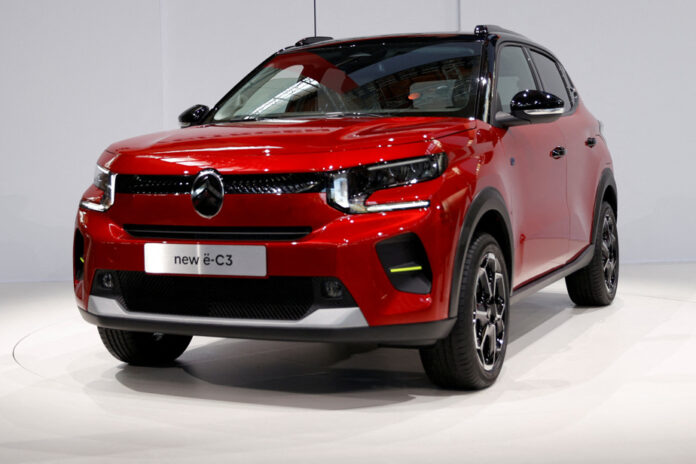(Meudon) French car brand Citroën unveiled the first electric version of its iconic C3 on Tuesday, making a flying start in the race for electric entry-level, with a car priced at 23,300 euros ($34,000), which will be followed by a reduced-range version, priced at 19,990 euros ($29,000).
“This is a real breakthrough in the market: a unique electric car, for less than 25,000 euros, made in Europe,” said Citroën CEO Thierry Koskas, next to an ë-C3 red with a black roof, freshly unveiled on the stage of Hangar Y, in Meudon (Hauts-de-Seine).
This car, with a range of 320 km – “more than sufficient for everyday use” – will be available “at a price of 23,300 euros”, net buyer and “unique in Europe”, praised Mr. Koskas.
And it promises even cheaper “at the beginning of 2025”, with a “more urban version with a 200 km range, which will cost 19,990 euros”. “Offering affordable vehicles has always been in Citroën’s DNA”, today in the fold of the Stellantis group, affirmed the manager.
The price can be further reduced thanks to the ecological bonus, once the government has confirmed that the ë-C3 is among the eligible models in 2024 (currently between 5,000 and 7,000 euros, it must become decreasing depending on income).
By comparison, Tesla’s best seller, the Model 3, now costs 37,990 euros ($55,000), once 5,000 euros in environmental bonuses are deducted.
This fourth generation of C3, which will also exist in a thermal version, will be available to order at the start of 2024 and marketed at the start of the second quarter.
Much squarer than the models that preceded it, the new C3 – “Citroën’s best-seller” with 5.6 million units sold since its launch in 2002 – is also taller (1.57 m), giving a false SUV appearance. The number of colors will be reduced to five to limit costs.
It will be the first vehicle to integrate the new Citroën design: the new logo, with chevrons enclosed in an oval as in the beginnings of the brand, and the “light signature” of the headlights, three bars drawing a C or an inverted C.
The LFP battery, 44 kWh, can be connected to fast charging at 100 kW, to “go from 20 to 80% capacity in just 26 minutes”, specifies the company. The same charge from a standard outlet will take between 2 hours 50 minutes and 4 hours 10 minutes.
“The new ë-C3 is the first fully electric versatile city car offered by a European manufacturer at this price level and for such benefits,” boasts Citroën. It will be manufactured at the “Stellantis Trnava factory in Slovakia”.
Currently, no model is sold in France under 30,000 euros, except the Dacia Spring, the cheapest electric on the market, but which is made in China and offers basic comfort.
Driven by fierce Asian competition, European manufacturers are engaged in a race for entry-level electric vehicles. Many brands – Opel, Renault, VW with its future ID.2 – have announced vehicles priced around 25,000 euros for the end of 2024 or 2025.
But the promise is difficult to keep. For its future Renault 5 city car, Renault management is now talking about a price rather “below 30,000 euros”, however arguing that it will be manufactured in France.
“The electric car below 25,000 euros is finally arriving,” welcomed Marie Chéron, of the environmental association Transport, to AFP.
“Nevertheless, the ë-C3 is a new example of “SUV-ification”” of electric, lamented his colleague Léo Larrivière, emphasizing that “it’s less energy efficient and more material consumed”.
Winning the race for the entry-level electric segment constitutes a strategic challenge for Citroën, whose sales are sluggish and buyers are aging. The ë-C3 constitutes a “decisive step” in Mr. Koskas’ roadmap, which aims for “a market share of at least 5%” in Europe.















